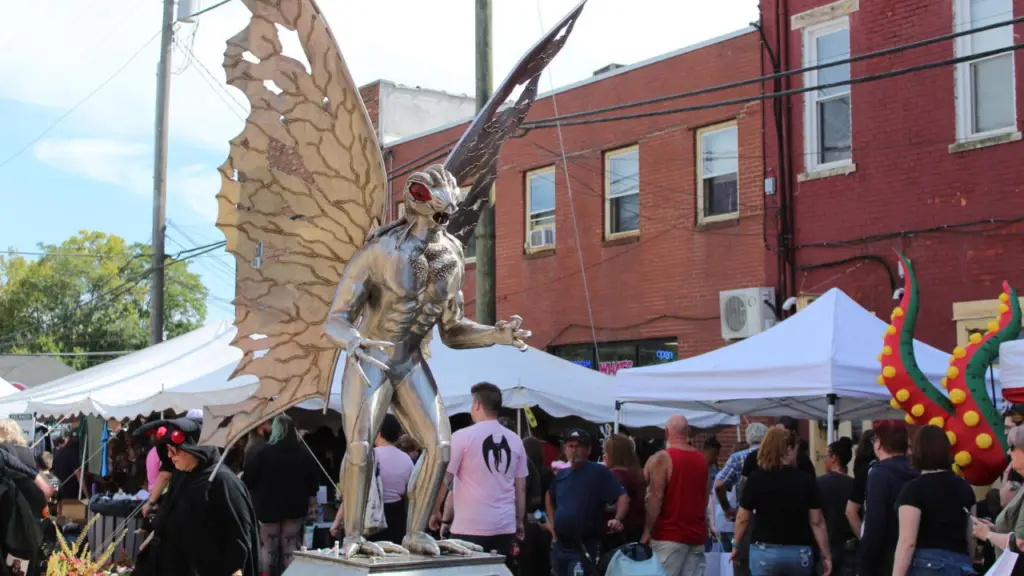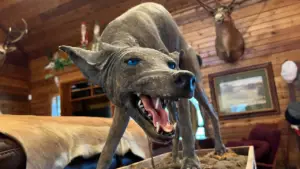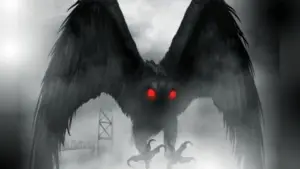The Mothman Legacy
In the decades following the tragic collapse of the Silver Bridge in 1967, the Mothman legend has transformed from a local mystery into a national cultural phenomenon. Point Pleasant, West Virginia, has fully embraced its connection to the mysterious creature, turning the town into a pilgrimage site for both the curious and the devoted.
The Mothman has become so intertwined with the town’s identity that its influence can be found throughout the community in a variety of forms.
Every year, the Mothman Festival, held in September, attracts thousands of visitors who come to celebrate the legend with a mix of curiosity, skepticism, and awe. The festival features a wide array of activities, from guest speakers and paranormal investigators to costume contests and Mothman-themed merchandise.
It has become a significant event not just for locals but for enthusiasts from across the country, turning Point Pleasant into a hub for cryptozoologists, horror fans, and anyone intrigued by the paranormal. The town’s annual festival is a vibrant reminder of how a piece of folklore can shape a community’s identity and economy.
In addition to the festival, the Mothman Museum has become a central point for learning about the history of the creature and the series of sightings that took place in the 1960s. The museum showcases a collection of newspaper clippings, photos, and witness accounts from the time of the sightings, as well as a variety of Mothman-inspired artifacts.
The museum serves not only as a historical archive but also as a gathering place for believers and skeptics alike, all of whom come together to discuss the legacy of the creature and its connection to the Silver Bridge disaster.
Perhaps the most iconic symbol of Point Pleasant’s connection to the Mothman is the towering statue that stands in the town’s downtown area. Unveiled in 2003, the Mothman statue is a 12-foot-tall, imposing figure that draws tourists and photographers from all over.
The statue, designed by artist Bob Roach, is depicted with glowing red eyes and large, bat-like wings, capturing the eerie and unsettling essence of the creature. It serves as both a tribute to the legend and a reminder of the town’s unique place in paranormal history. The statue has become an enduring symbol of the Mothman’s lasting impact on Point Pleasant.
The Mothman’s reach extends far beyond the borders of West Virginia, however. The legend has inspired countless books, documentaries, and movies, each exploring different theories about the creature’s origins and nature. One of the most famous works to delve into the mystery is the 1975 book The Mothman Prophecies by John Keel.
The book presents an exploration of the Mothman sightings alongside a series of other strange occurrences in the Point Pleasant area, including UFO sightings and alleged government involvement. Keel’s book, which combines investigative journalism with elements of the paranormal, was later adapted into a 2002 film of the same name, starring Richard Gere. The movie, though fictionalized, helped to bring the Mothman legend to an even wider audience.
Over the years, a wide range of theories has emerged to explain the Mothman sightings, with some attributing the creature to paranormal or extraterrestrial origins, while others propose more mundane explanations. Some suggest that the Mothman is an alien entity, sent to Earth as a harbinger of doom or to observe humanity.
Others point to the idea of a government experiment gone awry, perhaps linked to the chemical contamination and strange occurrences surrounding the nearby TNT plant. Still, others believe that the Mothman is a supernatural being, a demon or spirit tied to the land, perhaps even emerging from ancient folklore or the collective subconscious.
Skeptics, however, offer more grounded explanations. Many believe the Mothman sightings can be attributed to misidentified animals, particularly large birds such as the sandhill crane, which has a wingspan that could be mistaken for the creature’s reported dimensions. Others suggest that the accounts of the Mothman were the result of mass hysteria or the psychological impact of the Silver Bridge collapse, with people’s minds conjuring up a figure to explain the tragedy and the eerie feelings of fear and anxiety that followed.
Despite the numerous explanations, the Mothman legend continues to hold a powerful grip on the collective imagination, refusing to be easily debunked or dismissed. Whether a cryptid, a supernatural entity, or a product of folklore, the Mothman’s story has grown into something far more than a series of sightings in the small town of Point Pleasant. It has become a symbol of the unknown, a mystery that transcends its origins and touches on deeper fears and questions about the nature of reality, the supernatural, and the human experience.
The Mothman legend is inseparable from the history of Point Pleasant, and particularly from the eerie remnants of the TNT plant and the Silver Bridge disaster. It serves as a reminder of how local history, personal experiences, and collective fears can merge to create enduring stories that take on lives of their own, crossing boundaries between fact and fiction. The Mothman’s tale is not just the story of a creature, but a reflection of a community’s struggle to understand the unexplainable and to make sense of tragedy, fear, and the unknown.
Whether or not the Mothman was real, or if it was simply a product of imagination and misinterpretation, the creature has left an indelible mark on Point Pleasant and the broader landscape of American folklore. Its place in modern mythology is assured, a chilling reminder that some mysteries refuse to be solved, and that the line between reality and legend is often far thinner than we like to believe.
For Part 2 of Mothman.




One Response